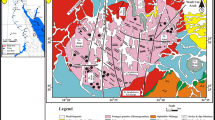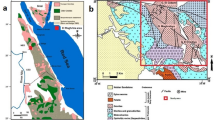Abstract
Zing-Monkin area, located in the northern part of Adamawa Massif, is underlain by extensive exposures of moderately radioactive granodiorites, anatectic migmatites, equigranular granites, porphyritic granites and highly radioactive fine-grained granites with minor pegmatites. Selected major and trace element petrochemical investigations of the rocks show that a progression from granodiorite through migmatite to granites is characterised by depletion of MgO, CaO, Fe2O3, Sr, Ba, and Zr, and enrichment of SiO2 and Rb. This trend is associated with uranium enrichment and shows a chemical gradation from the more primitive granodiorite to the more evolved granites. Electron microprobe analysis shows that the uranium is content in uranothorite and in accessories, such as monazite, titanite, apatite, epidote and zircon. Based on petrochemical and mineralogical data, the more differentiated granitoids (e.g., fine-grained granite) bordering the Benue Trough are the immediate source of the uranium prospect in Bima Sandstone within the Trough. Uranium was derived from the granitoids by weathering and erosion. Transportation and subsequent interaction with organic matter within the Bima Sandstone led to precipitation of insoluble secondary uranium minerals in the Benue Trough.




Similar content being viewed by others
References
Benkheli, J., & Robineau, B. (1983). Le fosse de la Benoue est-il un rift? Bulletin Centres Recherches Exploration Production Elf-Aquitaine, 7, 315–321.
Bowden, P. (1990). Uranium mining for the nuclear industry and its environmental consequences. In Major regional project: Geology for sustainable development (pp. 97–101). UNESCO Bulletin 10.
Collinson, J. D. (1986). Alluvial sediments. In H. G. Reading (Ed.), Sedimentary environments and facies (pp. 20–62). Oxford: Blackwell.
Coulon, C., Vidal, P., Dupy, C., Baudin, P., Popoff, M., Maluski, H., et al. (1995). The Mesozoic to early Cenozoic magmatism of the Benue trough (Nigeria); geochemical evidence for the involvement of the St Helena Plume. Journal of Petrology, 37, 1341–1358.
Cuney, M., & Kyser, K. (Eds.). (2008). Recent and not-so-recent developments in uranium deposits and implications for exploration. MAC Short Courses Series 39.
Fairhead, J. D., & Binks, R. M. (1991). Equatorial opening of the Central and South Atlantic Oceans and the opening of the West African rift system. Tectonophysics, 187, 191–203.
Flores, R. M. (1981). Coal deposition in fluvial paleo-environments of the Pleocene Tongue River Member of the Fort Union Formation, Powder River area, Powder River Basin, Wyoming and Montana. In F. G. Ethridge & R. M. Flores (Eds.), Recent and ancient non-marine depositional environments: models for exploration (pp. 169–190). Society for Economic Paleontology and Mineralogy. Special Publication.
Gersib, G. A., & McCabe, P. J. (1981). Continental coal-bearing sediments of the Port Hood Formation (Carboniferous), Cape Linzee, Nova Scotia, Canada. In F. G. Ethridge & R. M. Flores (Eds.), Recent and ancient non-marine depositional environments: Models for exploration (pp. 95–108). Society for Economic Paleontology and Mineralogy. Special Publication.
Guiraud, M. (1990). Tectono-sedimenttary framework of the Early Cretaceous continental Bima Formation (Upper Benue Trough, N.E. Nigeria). Journal African Earth Sciences, 10, 341–353.
Hostetler, P. B., & Garrels, R. M. (1962). Transportation and precipitation of uranium and vanadium at low temperatures, with special reference to sandstone-type uranium deposits. Economic Geology, 57, 137–167.
Kuptsova, A. V., Khudoley, A. K., Davis, W., Rainbird, R. H., Kovach, V. P., & Zagornaya, N. Yu. (2011). Age and provenance of sandstones from the Riphean Priozers and Salmi Formations in the Eastern Pasha-Ladoga Basin (southern margin of the Baltic Shield). Stratigraphy and Geological Correlation, 19, 3–19.
Le Roux, J. P. (1991). Flume experiments on permeability and organic matter as related to the genesis of uranium deposits in the Beaufort Group. South Africa Journal Geology, 94, 212–219.
Le Roux, J. P. (1993). Genesis of stratiform U–Mo deposits in the Karoo Basin of South Africa. Ore Geology Reviews, 7, 485–509.
Lisitsyn, A. K., & Kuznetsova, E. C. (1967). Role of micro-organisms in development of geochemical reduction barriers where limonitisation bedded zones wedge-out. International Geology Review, 9, 1180–1191.
Maluski, H., Coulon, C., Popoff, M., & Baudin, P. (1995). 40Ar/39Ar chronology, petrology and geodynamic setting of Mesozoic to Early Cenozoic magmatism from the Benue Trough, Nigeria. Journal of the Geological Society of London, 152, 311–326.
Mason, B. (1966). Principles of geochemistry (3rd ed.). New York: Wiley.
Ogunleye, P. O., & Okujeni, C. D. (1993). The geology and geochemistry of Zona uranium occurrence, Upper Benue Trough, N.E. Nigeria. Journal of Mining and Geology, 29, 175–181.
Popoff, M. (1990). Déformation intercontinental gondwanienne. Rifting mésozoïque en Afrique (Evolution méso-cénozoïque du fossé de la Bénoué, Nigéria). Relation avec l’ouverture de l’Océan Atlantique Sud. Thése d’etat, Université Aix-Marseille III.
Steacy, H. R., & Kaiman, S. (1978). Uranium minerals in Canada: their description, identification and field guides. In Short courses in uranium deposits: Their mineralogy and origin (p. 107). Toronto, Canada: University of Toronto Press.
Steel, R. J., & Thompson, D. B. (1983). Structures and textures in the Triassic braided stream conglomerates (‘Bunter’ Pebble Beds) in the Sherwood Sandstone Group, North Staffordshire, England. Sedimentology, 30, 341–367.
Watkinson, D. H., & Mainaring, P. R. (1976). The Kulyk Lake monazite deposit, northern Saskatchewan. Canadian Journal of Earth Sciences, 13, 470–475.
Author information
Authors and Affiliations
Corresponding author
Rights and permissions
About this article
Cite this article
Haruna, I.V., Orazulike, D.M., Ofulume, A.B. et al. Petrochemical and Mineralogical Constraints on the Source and Processes of Uranium Mineralisation in the Granitoids of Zing-Monkin Area, Adamawa Massif, NE Nigeria. Nat Resour Res 20, 355–366 (2011). https://doi.org/10.1007/s11053-011-9156-y
Received:
Accepted:
Published:
Issue Date:
DOI: https://doi.org/10.1007/s11053-011-9156-y




